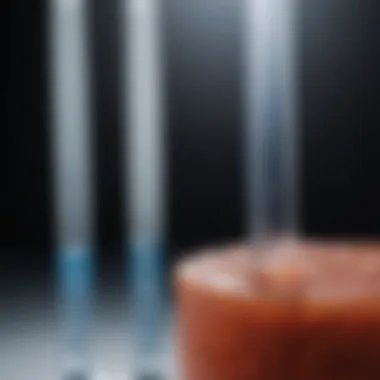Comprehensive Analysis of GPC Polymers and Applications


Intro
Gel Permeation Chromatography (GPC) serves as a cornerstone in the characterization of polymer samples. It is a powerful analytical technique that allows scientists to separate polymer chains based on their size. Understanding the molecular weight distribution of polymers is vital for various applications, including material science, engineering, and product development. This article delves into the methodologies associated with GPC and its diverse applications, emphasizing both recent advancements and existing challenges in the field.
GPC is not merely a laboratory technique; it plays a fundamental role in the advancement of materials used in everyday products. From plastics to elastomers, the ability to analyze the characteristics of these materials directly impacts their performance. Furthermore, keeping abreast of the latest developments in GPC methodologies and applications is essential for professionals working within polymer science.
Methodology
Study Design
The design of studies in GPC often varies based on the type of polymers being analyzed and the specific information sought. A systematic approach is essential for obtaining reliable data. Typically, a study will begin with formulating hypotheses related to the molecular weight and distribution of the sample. This is followed by the selection of appropriate GPC equipment, such as Agilent Technologies' 1260 Infinity GPC system or Waters’ Alliance GPC system.
Data Collection Techniques
Data collection during a GPC analysis involves careful execution of several steps:
- Sample Preparation: The polymer sample must be properly dissolved in a suitable solvent. This step is critical as improper solvation can lead to erroneous results.
- Calibration Curve Creation: Establishing a calibration curve using polymer standards is mandatory for accurate molecular weight determination. Calibration often involves polystyrene standards due to their well-characterized behavior.
- Running GPC Analysis: The sample is injected into the GPC system where it is eluted through a column packed with porous beads. The separation occurs based on size, allowing larger molecules to pass through more quickly than smaller ones.
- Collecting Data: Detectors, such as refractive index or UV detectors, gather data as the polymers elute from the column. The resulting chromatogram provides insights into the sample's molecular weight distribution.
Discussion
Interpretation of Results
Analyzing the resulting data involves several crucial components. The peak in the chromatogram represents the elution of polymers. The position and area under the peak relate to the molecular weight and concentration of the polymer, respectively. It is important to compare these results with the calibration curve to ensure accuracy.
Limitations of the Study
While GPC is a robust technique, it is not without its limitations. One major challenge is the dependency on solvent quality and the interaction between solvent and polymer. Variability in these factors can influence retention times and thus affect results. Furthermore, the inability to analyze highly polydisperse or certain branched polymers accurately remains a significant hurdle.
Future Research Directions
Future research in GPC should aim at developing more refined methodologies for analyzing complex polymer structures. The integration of GPC with other analytical techniques, such as Mass Spectrometry or NMR, could enhance characterization capabilities. Ongoing advancements in detector technology also hold promise for improving the resolution and accuracy of GPC analyses.
Prelims to GPC Polymer Analysis
Gel Permeation Chromatography (GPC) stands as a cornerstone in the domain of polymer analysis. Understanding GPC's role is essential for advancing polymer science and improving product quality across various industries. This introduction elaborates on the significance of GPC methodology, the insights it provides into polymer characteristics, and the implications of molecular weight determination.
The importance of GPC cannot be overstated. It offers a reliable means to analyze the molecular weight distribution of polymers, a critical factor influencing their physical and chemical properties. The data derived from GPC analysis informs decisions about material selection, production processes, and product formulation.
Historical Context of GPC
GPC has its roots in the processes developed in the mid-20th century. The initial methodologies focused on the separation of small molecules. As materials science evolved, the need to analyze larger polymer chains emerged. This led to refinements in the techniques, allowing for better resolution and accuracy in separating polymer samples. By the 1970s, GPC became widely recognized as a vital analytical tool for polymer scientists. Researchers were keen to understand the relationship between molecular weight and polymer behavior, leading to breakthroughs in material applications. GPC incorporated advancements in detector technologies, providing more precise measurements over time.
Importance of Molecular Weight Determination
Molecular weight determination is pivotal in polymer research and development. The molecular weight of a polymer affects its properties such as viscosity, tensile strength, and thermal behavior. Therefore, accurate measurement via GPC can significantly influence the usability of a polymer in practical applications.
The determination of molecular weight not only helps in quality control but also guides the design of polymer materials for specific applications. For instance, polymers with a high molecular weight often exhibit better mechanical properties. Conversely, low molecular weight polymers might be preferred in applications requiring flexibility and processing ease.
"GPC is indispensable for those aiming to optimize polymer properties and application suitability."
In summary, understanding GPC polymer analysis lays the foundation for advancements in polymer science. Both its historical development and its significance in molecular weight determination illustrate GPC's integral role in contemporary research and industrial applications.
Principles of GPC
The principles of Gel Permeation Chromatography (GPC) are foundational to understanding how this technique functions in analyzing polymers. GPC is essential for assessing the molecular weight and distribution of synthetic and natural polymers. Molecular weight plays a significant role in determining the physical properties of a polymer, such as its mechanical strength, thermal stability, and solubility. Knowing these characteristics is critical for developing materials tailored for specific applications.
Basic Mechanisms of Gel Permeation Chromatography
At the core of GPC are the basic mechanisms that govern the separation of polymers based on size. In this technique, a sample is dissolved in a solvent and passed through a column filled with porous gel particles. As the mixture travels through the column, smaller molecules permeate the porous structure, taking a longer path, while larger molecules are excluded from the pores and pass through the column more quickly. This differential mobility produces a size-based separation, with larger molecules eluting first. The effectiveness of GPC lies in its ability to produce high-resolution separations, thereby enabling accurate molecular weight determination.
The gel used in GPC acts like a sieve, effectively sorting the molecules as they are transported by the mobile phase. It is vital to choose the appropriate gel type and pore size based on the specific characteristics of the polymer being analyzed. For instance, a gel with smaller pores may be suitable for smaller polymers, but using it with larger polymers could lead to ineffective separations.


Separation Techniques in GPC
The separation techniques in GPC are diverse and are tailored to achieve specific analysis objectives. Several factors can influence the separation, including mobile phase composition, flow rate, and temperature. Here are a few notable separation techniques often employed:
- Size Exclusion Chromatography (SEC): This is closely related to GPC and is often used interchangeably. It focuses solely on the size of the molecules for separation.
- Multi-Detector GPC: Integration with multiple detectors can provide additional data, such as light scattering or viscosity measurements. This information can enhance the understanding of the polymer's properties.
- Temperature-Controlled GPC: Maintaining consistent temperature allows for more reproducible results, especially for temperature-sensitive polymers.
These various techniques allow researchers to fine-tune the GPC process and optimize it for the specific properties they wish to examine.
A firm understanding of the principles and mechanisms of GPC provides critical insight into polymer properties, which in turn informs material design and application.
Methodological Approaches in GPC
The methodological approaches in Gel Permeation Chromatography (GPC) are critical for accurate polymer analysis. A sound methodology contributes to the integrity of the results obtained from GPC tests. Understanding these approaches helps researchers and professionals in the field to choose the right protocols based on their specific analytical needs. Various elements, such as sample preparation and calibration, play an integral role in this methodology. They are essentially the backbone of GPC analysis, ensuring reproducibility and validity of results.
Sample Preparation Techniques
Sample preparation is a crucial first step in GPC analysis. Proper preparation influences the quality of the results. There are several techniques used for preparing polymer samples for GPC, including dissolution, filtration, and dilution. The choice of solvent is important. For instance, to analyze polystyrene, a non-polar solvent like tetrahydrofuran is typically used. The method of dissolving the sample should minimize any physical or chemical changes to the polymer. This ensures that the molecular weight distribution represented in the GPC results is accurate.
It is also vital to ensure that the sample is free from impurities. Contaminants can skew results and provide misleading information. Therefore, filtration is a typical step in the preparation process to remove any particulates. Moreover, achieving a suitable concentration is fundamental. Too concentrated a solution can lead to poor resolution during the chromatographic process, while overly diluted samples may not produce enough signal.
Calibration Methods in GPC
Calibration in GPC is essential for translating the detected signals into meaningful molecular weight distributions. There are two primary calibration methods: relative and universal calibration. In relative calibration, sample standards of known molecular weight are analyzed to create a calibration curve. This curve is used to determine the molecular weights of unknown samples. Common standards include polystyrene or polyethylene, depending on the polymer of interest.
Universal calibration offers a broader approach. It takes into account the differing interactions between the polymer samples and the GPC column, improving the accuracy of molecular weight determination. This method utilizes a universal calibration curve that relates intrinsic viscosity to molecular weight. Understanding the nuances of these calibration techniques is vital for accuracy, because errors in calibration can significantly impact results.
The integrity of GPC results relies heavily on both proper sample preparation and robust calibration techniques.
In summary, methodological approaches in GPC are not just procedural steps but rather crucial elements that define the quality of analysis. Understanding sample preparation techniques and calibration methods can enhance the effectiveness of GPC in polymer science. By meticulously following these methodologies, researchers can ensure that the results they obtain are both reliable and informative.
Applications of GPC in Polymer Science
The application of Gel Permeation Chromatography (GPC) is critical in the field of polymer science. GPC is predominantly used to analyze the molecular weight and the distribution of polymers, which are fundamental properties influencing the performance and quality of polymeric materials. The significance of GPC extends across various industrial sectors, from material science to pharmaceuticals. Understanding the molecular characteristics of polymers allows for innovations in product design and optimization in production processes.
Characterization of Polymeric Materials
Characterization involves understanding the fundamental properties of materials. In polymer science, GPC serves as a pivotal tool for characterizing polymers. It provides detailed information about molecular weight averages, such as weight-average molecular weight and number-average molecular weight. Each of these averages plays a distinct role in predicting how a polymer will behave in practical applications.
GPC can accurately depict the molecular weight distribution (MWD) of a polymer sample, offering insights into its structural properties. This data is essential for researchers and manufacturers to forecast the physical characteristics of the polymer such as tensile strength, elasticity, and thermal stability.
Moreover, GPC has the capability of analyzing copolymers and blends, making it indispensable for studying complex polymer systems. By analyzing the separation of different molecular weights in these materials, researchers can determine compatibility and interactions between polymer components. This analysis plays a crucial role in developing advanced materials for specific applications.
Quality Control in Polymer Production
Quality control is vital in maintaining the standards of polymer production. GPC is instrumental in verifying the molecular properties of polymers at various stages of production. By using GPC, manufacturers can ensure that the molecular weight and distribution fall within required specifications. This prevents production defects and ensures the end-product meets intended performance criteria.
Regular GPC analysis allows for real-time monitoring of a production batch. If inconsistencies arise in the molecular weight distribution, the production process can be adjusted immediately. This not only prevents waste but also enhances the overall efficiency of manufacturing processes.
Furthermore, GPC can help in assessing the effects of processing conditions on polymer characteristics. For example, variations in temperature or pressure can lead to changes in molecular weight. Having the capability to monitor and adapt to these effects promotes quality and consistency.
"Understanding the molecular weight and distribution is key to mastering polymer properties in applications.”
Quality control procedures enabled by GPC not only enhance product reliability but also support the move toward sustainable production methodologies.
Analysis of Polyethylene and Polystyrene Using GPC
The analysis of polyethylene and polystyrene using Gel Permeation Chromatography (GPC) holds significant importance in polymer research. These two polymers represent a substantial portion of the polymer market and serve as critical materials in various applications. Understanding their molecular weight and distribution yield insight into their physical properties, which directly influence their performance in industrial applications. GPC allows for precise measurements of these parameters, thereby enhancing material design and manufacturing processes.
Polyethylene Molecular Weight Distribution Study
Polyethylene, a widely utilized polymer, displays various forms based on its molecular weight. The molecular weight distribution (MWD) directly affects properties such as density, melting point, and mechanical strength. GPC is essential in determining MWD due to its ability to separate polymer chains based on their size.
In a typical GPC setup for polyethylene analysis, the sample is dissolved in a suitable solvent before passing through a column packed with porous beads. These beads allow smaller molecules to pass through while larger ones are eluted first. This differential migration creates a chromatogram, where the peaks correspond to different fractions of molecular weight. Analyzing this data aids in constructing a MWD curve that informs researchers about the polymer's characteristics.


The importance of MWD studies cannot be overstated. For manufacturers, specific molecular weight ranges can lead to optimal processing conditions. Additionally, products made from polyethylene, such as packaging materials, benefit drastically from tailored properties that are indicated through GPC analysis. Overall, this methodology not only facilitates academic research but also streamlines industrial applications of polyethylene.
Polystyrene Purity and Composition Analysis
Polystyrene, another significant polymer, often undergoes rigorous quality assessments due to its broad usage in various domains, like packaging and insulation. The purity and composition of polystyrene play a crucial role in determining its suitability for specific applications. GPC serves as a reliable technique for evaluating these qualities.
During a GPC analysis of polystyrene, the polymer sample is prepared similarly to polyethylene. The elution profile obtained reveals not only the molecular weight distribution but also information regarding the polymer's purity. Impurities can manifest as additional peaks in the chromatogram, allowing for precise quantification of contaminants or additives. Analyzing these impurities is fundamental for ensuring product quality and conformity to regulations.
Moreover, composition analysis through GPC can elucidate the ratio of different styrene block copolymers present in the sample. Understanding this composition is vital for tailoring the physical properties of polystyrene-based products to meet specific performance criteria, such as flexibility, thermal stability, or transparency.
"Understanding the purity and composition of polystyrene via GPC significantly contributes to the advancement of polymer applications and technology."
In summary, GPC's utility in analyzing polyethylene and polystyrene substantially enhances knowledge regarding their molecular weight distributions, purity, and overall performance. As research and industry continue to evolve, GPC remains an indispensable tool in polymer analysis, underpinning advancements in the field.
Emerging Trends in GPC Technology
Emerging trends in Gel Permeation Chromatography (GPC) technology reflect the ongoing advancements in the field of polymer analysis. As industries evolve, the demand for precise and efficient methodologies to characterize polymers becomes increasingly critical. These emerging trends not only enhance existing processes but also pave the way for innovative applications in various sectors.
Advancements in Detectors
Recent innovations in detectors for GPC systems significantly improve the sensitivity and accuracy of analyses. The development of multi-angle light scattering detectors, for instance, allows researchers to obtain more detailed insights into molecular weight and size distribution of polymer samples. This is particularly important when working with complex polymer mixtures, where traditional detectors might struggle to provide a clear picture.
Moreover, advancements in refractive index detectors offer enhanced stability and precision. They enable researchers to assess concentration changes with greater confidence, leading to more reliable results. A notable example is the use of differential refractive index detection paired with light scattering detectors, which offers complementary data that can greatly refine molecular characterization.
Incorporating advanced detectors into GPC systems also promotes automation and integration with data analysis software. This not only improves efficiency but also enhances reproducibility in results, a vital aspect when conducting rigorous scientific research.
Integration of GPC with Other Techniques
The integration of GPC with other analytical techniques represents a pivotal development in polymer research. For instance, coupling GPC with Nuclear Magnetic Resonance (NMR) spectroscopy provides a comprehensive view of polymer structure alongside its molecular weight. This combined approach yields insights into both the composition and behavior of different polymer types, facilitating a more thorough examination.
Another compelling example is the synergy between GPC and Mass Spectrometry (MS). This integration allows researchers to analyze polymer fragments and achieve more definitive results concerning polymeric materials. By using GPC to separate components followed by MS analysis, scientists can elucidate polymer structures and functional groups with higher precision.
Moreover, the rise of hyphenated techniques such as GPC-FTIR (Fourier Transform Infrared Spectroscopy) offers a means to study both the physical characteristics and chemical nature of polymers simultaneously. This multifaceted approach is valuable for applications in durability testing and quality assurance processes.
"The future of GPC technology depends on our ability to innovate and integrate. Enhanced detectors and methodological synergies will shape how we understand polymer science."
Challenges in GPC Analysis
Understanding the challenges inherent in Gel Permeation Chromatography (GPC) analysis is crucial for practitioners and researchers alike. GPC plays a pivotal role in polymer science, yet several complications can arise during its optimization and application. The limitations present both obstacles and opportunities for advancement in the field. Identifying these challenges can guide improvements in methodologies, thereby enhancing the analysis of polymers.
Limitations of Current GPC Techniques
Current GPC techniques face various limitations that affect the accuracy and reliability of results. Some notable issues include:
- Sample Solubility Issues: Not all polymers dissolve adequately in the solvents used in GPC. This can lead to poor separations and inaccurate molecular weight distributions.
- Detector Sensitivity: Many detectors, such as refractive index detectors, have limitations in sensitivity, particularly for low concentration samples. This can prevent accurate measurements.
- Calibration Standards: The use of calibration standards can introduce errors if the standards do not match the sample's properties. This discrepancy can skew the results and lead to faulty conclusions.
- Temperature Control: Variations in temperature during analysis can affect molecular interactions and measurements. Consistent temperature control is vital, yet challenging in practice.
These limitations necessitate further investigation and innovation to ensure reliable GPC results.
Overcoming Analytical Challenges
Tackling the challenges of GPC analysis requires a strategic approach. Researchers and technologists can consider several methods to improve the robustness of this technique:
- Improved Solvent Selection: Choosing the right solvent for each polymer can aid in achieving better solubility and separation. Selecting solvents based on the polymer's chemical nature can lead to more accurate results.
- Advanced Detection Methods: Integrating more sensitive and accurate detection methods, such as multi-angle light scattering (MALS) or nuclear magnetic resonance (NMR), can enhance analytical capabilities and provide greater insight into polymer characteristics.
- Standardization of Calibration Techniques: Developing better calibration methods using more compatible standards can minimize discrepancies and improve accuracy in measurements.
- Automated Temperature Control Systems: Implementing advanced automated temperature control can help maintain consistency throughout the analysis process.
"Innovations in GPC methods can significantly enhance the reliability of polymer characterizations, leading to a deeper understanding of material properties."
In summary, while challenges exist in GPC analysis, great strides can be made through targeted innovations. Addressing these challenges not only improves GPC methodologies but also ensures that they continue to play a vital role in advancing polymer science. The outcome of these improvements can lead to more robust research and applications in various industrial sectors.
Comparison with Alternative Techniques
In the realm of polymer analysis, it is crucial to evaluate different methodologies to obtain the most accurate and relevant data. Comparing Gel Permeation Chromatography (GPC) with alternative techniques enhances understanding of each method’s strengths and limitations. This comparison assists researchers in selecting the most effective approach for their specific analysis needs.
GPC vs. Light Scattering Techniques


While GPC focuses primarily on molecular size and distribution within polymer samples, light scattering techniques provide complementary data about molecular weight and structure. The foremost advantage of light scattering is its ability to analyze smaller amounts of polymer than GPC. The interplay of light scattering can yield immediate insights into the absolute molecular weight without the need for calibration against standards.
However, light scattering methods can show limitations when dealing with complex polymer mixtures. The analytical results may be influenced by the scattering effects from various components. In contrast, GPC offers valuable data on the polydispersity of polymers but sometimes necessitates a larger sample to achieve reliable outcomes.
The selection between these techniques often rests on the specific goals of the analysis:
- For molecular weight distribution: GPC is effective and widely used.
- For rapid and precise molecular weight measurements: Light scattering is preferred, especially for samples with lower concentrations.
GPC vs. Size Exclusion Chromatography (SEC)
Size Exclusion Chromatography (SEC) is often treated as synonymous with GPC; however, some subtle distinctions exist between these two techniques. Both methods utilize a similar platform based on molecular size but differ in their applications and scope. SEC is a more general term that can encompass various types of chromatographic separations based on size. GPC, specifically, is designed to analyze polymers.
One of the key benefits of GPC is its effectiveness in examining high molecular weight polymers and providing insights into their polydisperity. In comparison, SEC may cover a broader range of compounds, not limited to polymers. Therefore, GPC might offer enhanced sensitivity and resolution when characterizing synthetic and natural polymers.
Despite their similarities, consideration of sample types and desired results should drive the choice between GPC and SEC. Both techniques can yield essential information, yet their specific applications may lead to different insights. GPC may outperform SEC in certain polymer-related analyses, making it a preferred choice for polymer scientists.
"Choosing the right analytical method is as important as the analysis itself. Careful consideration yields more reliable results!"
The evaluation of these techniques highlights the unique benefits and complexities associated with each, informing researchers as they navigate the intricate landscape of polymer analysis.
The Future of GPC in Polymer Research
As we delve deeper into the landscape of polymer research, understanding the future of Gel Permeation Chromatography (GPC) becomes crucial. GPC has already established itself as a foundational tool for polymer characterization and analysis. The techniques and methodologies used in GPC are continually evolving, leading to significant advantages in accuracy and efficiency.
This section will explore both the potential for innovations and the implications for sustainable practices within the field.
Potential Innovations and Improvements
GPC technology is on the brink of substantial advancements. There are several areas of innovation that can impact GPC's functionality:
- Improved Detector Technologies: The integration of new detector types, such as multi-angle light scattering (MALS) and differential refractive index (DRI) detectors, may enhance sensitivity and resolution. These developments allow for more precise measurements of polymer properties, thus expanding the scope of GPC applications.
- Automation and Robotics: Automating sample handling and data collection will streamline processes, significantly reducing human error. This will enable researchers to process a larger number of samples in less time.
- Enhanced Software for Data Analysis: With advances in data analytics and machine learning, software could more accurately interpret complex datasets. The adoption of sophisticated algorithms may provide more insights into the molecular behavior of polymers.
- New Column Materials: Research into novel polymers for GPC columns could allow for better separation and greater resilience against degradation, further optimizing the performance of GPC methods.
These innovations promise to make GPC a more robust and versatile method for polymer analysis.
Implications for Sustainable Polymer Research
As the global focus shifts towards sustainability, GPC can play an integral role in promoting environmentally friendly practices within polymer research. Key implications include:
- Biodegradable Polymers: As research into biodegradable materials increases, GPC can aid in characterizing these polymers. Understanding their molecular weight and distribution is essential in determining their degradation rates.
- Recycling: GPC can support advancements in polymer recycling by allowing researchers to examine the quality and characteristics of recycled materials. This insight aids in the development of effective recycling techniques that maintain polymer integrity.
- Resource Optimization: By providing accurate molecular weight data, GPC helps researchers optimize resource use during polymer synthesis. Enhanced understanding of polymer properties can lead to less waste and more efficient manufacturing processes.
In summary, GPC is well-positioned to evolve alongside the demands of contemporary research. The innovations on the horizon will strengthen its role in polymer science, while its applications may contribute significantly to sustainable practices in the industry.
Ending and Summary of Findings
In this article, we explored the role of Gel Permeation Chromatography (GPC) in analyzing polymers. GPC is essential for understanding polymer structure and function. It provides insights into molecular weight distributions, which directly affect the physical properties of polymers. Accurate determination of these properties has significant implications for various applications across industries, from materials science to pharmaceuticals.
The findings showcase the versatility of GPC methodologies in addressing complex analytical challenges. For instance, advancements in detection technologies and the integration of GPC with other analytical methods enhance both accuracy and efficiency. These innovations also pave the way for more sustainable practices in polymer research. Understanding the varied applications of GPC allows researchers and professionals to leverage its capabilities better.
Moreover, the inspection of challenges faced in GPC analysis highlights the necessity for continuous improvement in techniques and methodologies. This perspective is vital as it fosters innovation within the field, encouraging researchers to find novel solutions to existing problems.
Key Point: GPC serves as the backbone of polymer analysis, bridging fundamental research with practical applications, ensuring that polymer materials meet rigorous industry standards.
Overall, the conclusion drawn from this comprehensive analysis points to GPC’s indispensable role in both current practices and future explorations in polymer science. As the field evolves, GPC will remain a critical tool for unraveling the complexities of polymer behavior and development.
Key Takeaways from GPC Analysis
The application of GPC in polymer science offers several key takeaways:
- Molecular Weight Distribution: GPC accurately measures molecular weight, helping to predict polymer characteristics effectively.
- Versatility: The methodology can be adapted for various types of polymers, underscoring its broad applicability across different sectors.
- Advancements: Continuous advancements in GPC technology improve the precision and efficiency of analyses, facilitating high-quality research and production.
- Interdisciplinary Integration: Combining GPC with other techniques enhances its analytical capability, providing a more comprehensive understanding of materials.
These takeaways highlight the foundation GPC provides for both current polymer studies and future innovations.
The Role of GPC in Future Research Endeavors
As we look to the future, GPC’s role in research endeavors is poised to expand further. The following elements illustrate its significance:
- Innovation Pathways: GPC technologies are continuously evolving and will likely adopt innovations that improve analysis methods, especially in response to emerging material needs.
- Sustainable Practices: GPC’s ability to analyze and refine polymer formulations aligns with the growing focus on sustainability in research. This is particularly important as industries work towards greener solutions.
- Collaborative Research: Interdisciplinary projects increasingly utilize GPC to explore new applications and functionalities for polymers, fostering collaboration across fields such as chemistry, engineering, and environmental science.
In concluding, GPC stands as a pillar of polymer research. It not only enhances our understanding of materials today but also shapes the future landscape of polymer science as we seek solutions to pressing global challenges.







